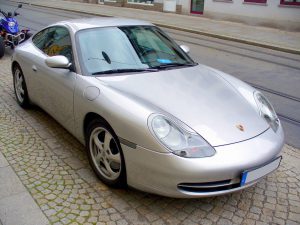
History
The introduction of the 996-model Porsche 911 in 1997 was not universally seen as a good thing. Not only did 911 lovers have to live without an air-cooled engine, but also have to accept the “fried egg” headlights that Porsche carried over from the Boxster as a cost-cutting measure. Moving to a liquid-cooled engine was of course a necessity for more performance and better heating and emissions. The headlights were modified with the facelift, and went back to round headlights with the successor 997 and have stayed round ever since.
The initial engine offering was a 3.4l with 300hp. A six-speed manual transmission was standard. Four-wheel-drive was available as option (Carrera 4), and standard on the 420hp turbo that was introduced in 1999. 2002 saw a facelift with new headlights (as featured on the turbo), displacement increased to 3.6l and power to 320hp. The Carrera 4S combined the Carrera 4 drivetrain with the wider turbo body.
The 996 was also sold as Targa and Convertible. The most desirable 996 models are the GT3 and GT2. The GT3 is the first of its kind, aimed at the track enthusiast. The GT2 is based on the turbo, but rear-wheel drive only.
The 996’s M96 engine has earned a reputation for unreliability. Must publicized are the IMS (intermediate main shaft) bearing issues. There are actually three different IMS bearing designs, with the later single-row bearing being more likely to fail (though hard numbers appear to put the likelihood in the 5-8% range). The later 3.6l sees cases of cylinder wall scoring. The 3.4l on the other hand seems to have isolated cases of cracked heads and cylinder liners – with some people claiming that if a car hasn’t developed cracks after 50,000 miles, it will be fine in the future.
The Turbo, GT3, and GT2 use a Mezger-based engine without these issues.
Performance
300hp and 350nm of torque may not sound much in this age of turbo-charged engines, but one has to remember that this car is 20 years old and has a dry weight of less than 1,400kg for the base-model Carrera. From this results an 0-100kph time of 5.2s and a top speed of 280kph for the 3.4l model, which is still respectable by today’s standards. The other models are faster, of course, though not spectacularly so- even the GT2 can only shave off an additional second for the sprint to 100kph and is about 10% faster, cracking the 300kph barrier.
Pros
- The cheapest 911 out there, thanks to the unloved headlights
- Porsche build quality
- Porsche brakes
- Lighter and smaller than the successors, early models still have a throttle cable
- Did I say that it is THE CHEAPEST 911!? But prices are starting to rise, so buy now.
Cons
- Known and well-understood engine issues (see above)
- Interior shows its age – but you can get a new PCCM+ audio/nav system from Porsche
- Porsche prices for parts and maintenance – beware of cars that have not had regular servicing, a complete maintenance record is pretty much a must
My pick
Early Carrera in blue, with dark interior, three-spoke steering wheel, and no sunroof.